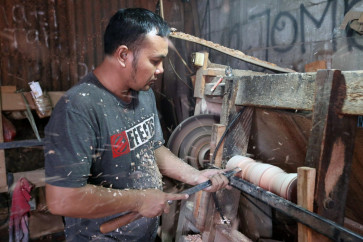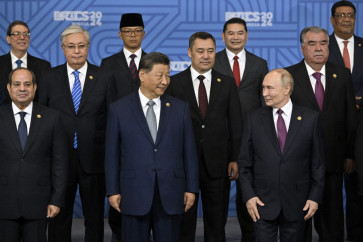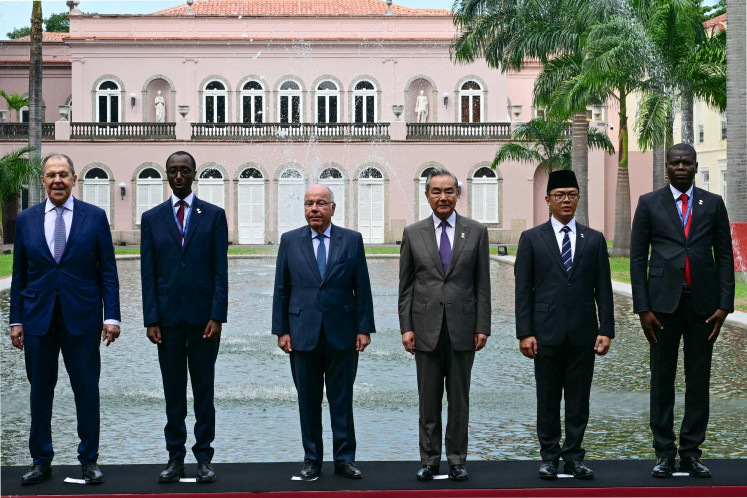Indieguerillas: For the love of art & creative freedom
Artist couple Dyatmiko âMikoâ Lancur Bawono and Santi Ariestyowati celebrate love the way they know best â by creating art
Change text size
Gift Premium Articles
to Anyone

Artist couple Dyatmiko 'Miko' Lancur Bawono and Santi Ariestyowati celebrate love the way they know best ' by creating art.
In their artistic house in Yogyakarta, Miko and Santi are currently busy creating a work of art titled Taman Budaya (Cultural Park).
The husband-and-wife team ' renowned as Indieguerillas ' was commissioned to create the artwork for the eighth ArtJog exhibition to be held at the Taman Budaya Yogyakarta cultural center in June this year.
'This is a challenge for us since we have to create outdoor works. Usually we craft for indoor purposes,' Santi said in her sitting room in a traditional Javanese building adjacent to their studio. The couple lives in a modern-style house built on top of the studio.
Miko and Santi concealed the work they created for ArtJog ' simply revealing that the pieces were small in size but large in number ' and in need of a big space to display.
ArtJog director Heri Pemad said Indieguerillas were chosen since their works were considered most suited to the upcoming exhibition's theme, 'Infinity inFlux: The Unending Loop that Bonds the Artist and the Audience'.
He said Indieguerillas' works merged art and non-art elements, showcasing not just artistic beauty but also involving scientific, environmental and functional features.
'Their works will be positioned in the exhibition's front area, the first sight that will greet visitors,' Heri said.
Indieguerillas came from the name of a graphic design bureau that the pair set up back in 1999. It derives from the word indie, which stands for independent, and guerillas, denoting the way they are struggling for creative freedom.
In 2002, they decided to enter the fine art world ' producing artwork based on contemplative messages, not just to satisfy customers' orders.
Santi felt Indieguerillas should focus on their work as they could not rely on the 'work' (creating graphic design pieces) and 'play' (in making artwork) principles they were using at the time.
'We finally decided to focus on creating art since we are comfortable with it and gain much appreciation,' said the 38-year-old Santi, who studied graphic design at the Indonesian Fine Arts Institute (ISI) in Yogyakarta.
In their works, Indieguerillas aim to communicate various issues faced by Indonesians, many of whom, they find, are being extracted from their culture and becoming bewildered amid modern and fast-changing urban life.
Together, in order to illustrate such issues, they introduce icons of traditional and popular culture through their paintings, mixed media pieces, animations, sculptures and installations.
One of their works, titled I got ten celebrities' heads but Hefner ain't one, for instance, visualizes a youth with 10 heads of pop-culture images like Captain America and the Hulk painted on five skateboards. The ten-headed man is inspired by Dasamuka, a devil king in the epic Ramayana.
'Through the piece, we want to remind young people now living in the capitalist era of the need to preserve their history and culture,' said the 40-year-old Miko, who studied interior design at the ISI in Yogyakarta.
In a painting called Punkers Agraris, Indieguerillas portrays a wayang (shadow puppet) character, Petruk, in a punk style. They seem to allude to young people in agrarian Indonesia who have chosen to be punks, a product of the industrialist world.
Hermanto Soerjanto, curator of an Indieguerillas' exhibition titled 'Indie Who, Indie What' (2010), wrote how computer and digital print technology in the design sphere had opened the opportunity for Indieguerillas to make further artistic explorations.
He said they combined computer technology and conventional methods to turn out fresh and attractive pieces. 'When Indieguerillas deform wayang figures to convert them into cartoon characters, they have actually created new forms of art,' Hermanto said.
Miko and Santi, who tied the knot in 2002, have always collaborated in producing their works. Starting with a long discussion on theme and visual shapes, they later execute works together without any rigid division of tasks.
Their collaboration has not always been smooth ' they fight at times about having different ideas.
'A piece I created in the evening could be changed by Miko. It's like the takeover process in street art,' Santi says.
'We see it as a form of dialog,' added Miko.
Miko said the husband-and-wife dynamics may have affected their art-making process but they did not let it affect their creative process. 'Problems in the top house (where they live) should not seep into the lower house (their studio),' he said.
Santi said when working together, they just go with the flow, naturally. 'There's no separation between private life and creation. We're also mutually complementary in the artistic process and doing household chores.'
They may have yet to have children but both see their works as their 'babies'. Some of their works, like the painting This Hegemony Life, decorates their living room.
The piece distorts the work of painter Raden Saleh, which depicts the capture of Prince Diponegoro, into a comic style work resembling Hergé's Tintin adventure.
Santi said the painting is on display in the ongoing exhibition 'Sang Pangeran Dalam Ingatan Bangsa, dari Raden Saleh Hingga Kini' (The Prince in the nation's memories, from Raden Saleh to the present) at the National Gallery in Jakarta.
Together, Indieguerillas have created hundreds of works, displayed at home and overseas. Some have even found homes in museums abroad, such as in Singapore and Guangzhou, China.
Santi said Indieguerillas would continue their guerrilla attack on human thoughts ' with their works serving as 'bombs' to explode and encourage people to consider their attitude, behavior and the problems they face in an ever-changing urban world. 'We'll be creating endlessly,' she said.
' Photos courtesy of Indieguerillas









